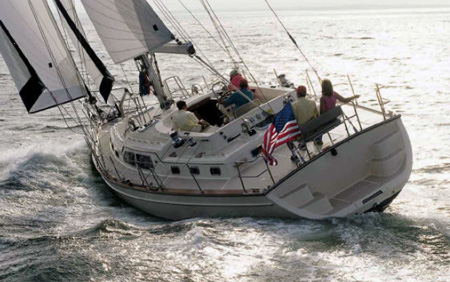Cruising with your staysail can add horsepower and ease, giving you options in a variety of conditions. Learn how to make the most of your cruising experience with Quantum expert Dave Flynn’s staysail trim guide.
 close reaching, 12 knots of breeze.
close reaching, 12 knots of breeze.
The staysail plays three roles:
- It augments sail power.
- It helps break down total sail area into smaller working components for ease of handling.
- The smaller sail units allow for different combinations, giving sailors a variety of options for different conditions.
To make the most of your staysail, learning how to trim it is key. First though, it helps to know the right conditions for using a staysail.
Conditions
As part of the overall sail power of your boat, the staysail is most useful in the middle range of reaching angles, from a close reach to the point where the wind is slightly aft of the beam (50-130 degrees apparent wind angle). As the boat sails at broader angles, the blanket of the mainsail, as it is eased out, limits the effectiveness of the staysail. Eventually, the staysail will be hidden behind the mainsail. At closer angles, when sailing to windward, the staysail can help augment horsepower.
As the headsail, staysail, and mainsail are trimmed in, the gap (slot) between them narrows, and they begin to affect each other. In lighter conditions (under 10-12 knots apparent), the staysail may inhibit, not help, upwind performance. In the middle ranges, the staysail can be more helpful, depending on factors like sail shape and sheeting angle. In windy conditions, as the mainsail has to be eased, lowering the staysail will allow the mainsail to breathe and reduce back-winding, helping to keep the boat on its feet. In short, the optimum conditions for the staysail (when adding horsepower), are at apparent wind angles of 50-130 with a minimum apparent wind velocity of 10-12 knots.
Trim
Trim of the staysail is really no different than any other headsail. When reaching, keep in mind the first rule of sail trim: when in doubt, let it out.
Most sailors tend to over trim. Make sure the sail is eased to the point of luffing, then trim to barely remove luff. If your boat is not equipped with a Hoyt club boom, the sheet lead should be moved to the outboard rail as the sail is eased out. The lead position should follow the clew, moving slightly forward and outboard.
If your boat is equipped with a Hoyt boom, the staysail’s tendency to twist (leech opening up and causing the top of the sail to luff before the bottom) can be controlled by the boom. The Hoyt boom makes the staysail more useful at broader wind angles since sail shape is maintained and the sail is extended straight away from the boat as it is eased. There is less interference with the mainsail as a result.
Upwind, trim in tight, but be careful. When looking up the sails from the aft quarter, the slot between the three sails should be roughly parallel. The genoa should be trimmed in almost to the spreader – trim the staysail to match this profile.
If your boat has a conventional jib track, make sure the lead isn’t too far forward. If it is, the foot of the sail will be round and full. This will just create back winding in the mainsail. Drop the lead aft until the foot of the staysail is flat. With a Hoyt boom, make sure the outhaul is pulled tight to achieve flat foot sections.
Conclusion
When it gets windy, the staysail is the perfect sail. Used in combination with a partially-furled genoa or working jib and a reefed mainsail, the staysail provides plenty of power. Various combinations of reefs and headsail size allow the boat to be balanced in every condition.
Don't miss Quantum's trim guides for your headsail, mainsail, and asymmetrical sail.
____
Dave Flynn
Quantum Sails – Cruising Guru
410-268-1161
dflynn@quantumsails.com